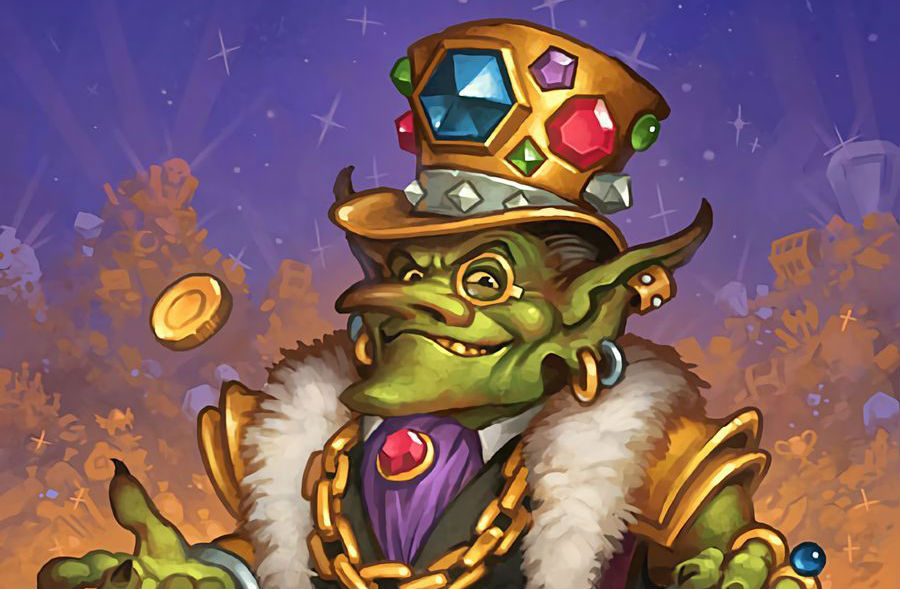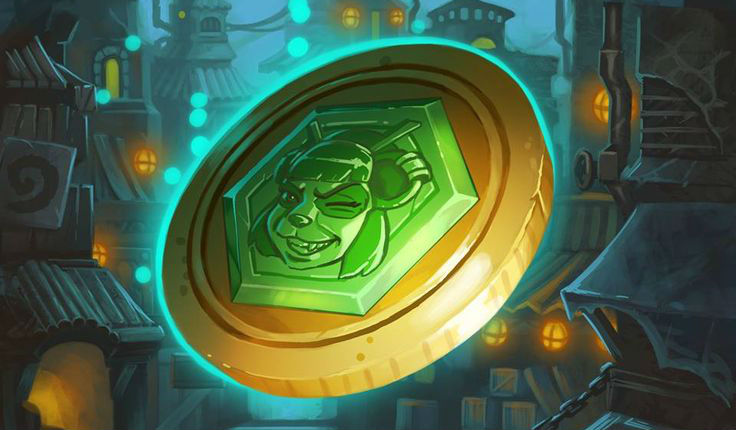Has Hearthstone become too expensive to keep up with?
The cost of maintaining a full collection has doubled since launch, and doesn't seem likely to get cheaper anytime soon.

It’s a scenario that all but the richest Hearthstone players will be familiar with. There’s a hot new deck tearing up the ladder, but to play it you need to craft a powerful new legendary card. This time the deck is Tempo Rogue, the centerpiece of which is Prince Keleseth, a card that hardly saw any play before the recent nerfs to Fiery War Axe and Innervate. Time to grab my wallet and buy another bundle of packs, hoping to scrape together enough dust to craft the coveted prince. Which, it turns out, was totally worth it as I crush my opponents while climbing.
Trading card games have always been an expensive hobby, as any Magic: The Gathering fan will attest, but when Hearthstone entered the market as a fully digital game, it offered a genuine free-to-play experience. But over time Hearthstone has become progressively less friendly to players on a limited budget. In the past 18 months, Blizzard has rolled out one change after another that has made staying competitive increasingly costly. Some of those changes, like price rises for packs in the EU are obvious, with the UK hit hardest thanks to the post-Brexit exchange rate fluctuation. Other changes are more difficult to spot, but continue to tighten the screws on fans.
In the past 18 months, Blizzard has rolled out one change after another that has made staying competitive increasingly costly.
The biggest change has been the end of Adventure expansions. Previously, every other content release was an Adventure, a series of single-player PvE battles available for purchase over the course of a month or so that guaranteed you a suite of card rewards upon completion. Though the card pool was much smaller, Adventure sets were way cheaper to complete than the larger expansions, in which cards are acquired randomly from buying packs with in-game gold or real money. Blizzard first cut the number of Adventures down to one every three content releases, and finally they were discontinued altogether at the start of this year's Standard rotation. You do still get some PvE content though. The most recent expansion, Knights of the Frozen Throne, came with well-received missions culminating in a battle against the Lich King. These missions were given out for free, but didn't earn you any cards either. Those you had to pay for.
Started a F2P Asia acct since Un'Goro, never missed dailies/TBs. Saw a cool variant of my fav deck...this is how much of it i can afford lol pic.twitter.com/ttkQC78iFeOctober 5, 2017
I estimate that the cost of maintaining a full collection has increased gradually from around $550 per year to almost $1,000 per year. However, looking at the cost of a full collection is misleading. Firstly, expansions typically include around 130 cards compared to the 45 found in adventures, so this year there will have been more cards released than ever before.
Secondly, collectible card games are not designed with full collections in mind: you don't need anything close to a full collection to play the game competitively, because many of the cards in a set will be filler that no serious player would touch. Either way, there's no mistaking the cost creep. In Hearthstone's early days it was possible to earn the equivalent of $500 year in gold simply by playing heavily. Now that will only get you halfway there.
The Legendary problem
What has really hurt the average player has been changes to the design of cards, and specifically the distribution of rarities. There used to be one Legendary card for each class in each expansion, the rest were neutral and available to all classes. I managed to play in the Mean Streets of Gadgetzan meta just fine on the back of the unholy trinity of Aya Blackpaw, Patches the Pirate, and Kazakus—three immensely powerful neutral legendary cards.
The cost of maintaining a competitive collection rises insidiously as improved card quality requires players to add another 50 packs per set to the shopping list.
Journey to Un’Goro marked a major change with its Quest cards. Each class received its usual Legendary minion plus a Legendary Quest, effectively doubling the cost. The good news, from the cash poor player's point of view, was that most of the Quests were pretty bad, meaning you needn't worry about crafting them, though this did mean missing out on the fun of messing around with the set's marquee cards. Knights of the Frozen Throne took a similar approach with its big theme: Hero cards. These have proved pretty good, with Scourgelord Garrosh, Bloodreaver Gul’dan, Shadowreaper Anduin, Deathseer Thrall, and Malfurion the Pestilent all seeing substantial play. As a result, the number of good Legendaries has crept up over the course of the last two sets.
Keep up to date with the most important stories and the best deals, as picked by the PC Gamer team.
The same cost creep has also been applied to Epic cards, the next rarity down from Legendary. The Journey to Un’Goro expansion was packed with a ton of must-have Epics. Playing Mage without two copies of Primordial Glyph or Priest without double Shadow Visions? Good luck with that. Opening zero copies of those cards and six copies of Tortollan Primalist—a prime contender for the Worst Epic of the Year—raised my salt level considerably. The cost of maintaining a competitive collection rises insidiously as improved card quality requires players to add another 50 packs per set to the shopping list just to keep up with the meta.

The fact that cards don't rotate out from the evergreen Basic and Classic sets have made them a safe haven for returning players and new players, but Blizzard's designers have repeatedly lamented the high inclusion of these cards in decks, which can make the meta feel stale. Many of the strongest evergreen cards have been nerfed or rotated out of Standard to encourage players to try new cards, and there is no end to this process in sight.

Along with Sylvanas the Windrunner, Ragnaros the Firelord was so deemed such a good card that he was sent to the Hall of Fame and removed from Standard play. Owners were given free dust in exchange to craft a replacement.
Players have been compensated in part by dust refunds equal to the crafting value of the cards, and many initially greeted this move with enthusiasm: the popular Legendary cards Ragnaros the Firelord and Sylvanas Windrunner rotated out of Standard in Spring 2017, and players were handed dust equivalent to their full value to soothe the sting. But in hindsight, crafting a rotating Legendary card—and most likely a class-specific one—did not really compensate for the loss of powerhouse staples that you could always fall back on if you didn't have the latest hotness.
This series of individually understandable changes—Standard rotation, the switch away from Adventures, increasing quality of higher rarity cards, and nerfs to the Basic and Classic sets—have combined to turn Hearthstone from a free-to-play game into the most expensive on Blizzard's roster.
With Hearthstone's massive success, competition has stirred, and rival games are eager to increase their market share by being more generous to their players. For example, in addition to the daily quests familiar from Hearthstone, Shadowverse gives daily login bonuses, as does The Elder Scrolls: Legends, which also hands out free packs and currency in the form of Twitch drops. Elsewhere, Eternal and Gwent provide new players with decent starter decks. Most games also hand out level-up rewards, and the daily and end-of-season rewards are generally of much better value than Hearthstone.
Inconsistent promotions
Blizzard recently took a step to make Hearthstone cheaper: Legendary card drop rates were changed by removing duplicates and giving you a guaranteed Legendary within the first ten packs you open from a new set. This move mostly makes a difference for those who either aim to collect a full set or those who only open a few dozen packs and get a couple of Legendary cards per set. It has also experimented with temporary reward schemes: the Fire and Frost festivals in Summer 2017 featured increased gold rewards, free Arena tickets, and one-off giveaways like the free Fight Promoter. However, it's unclear which of these events will be repeated.
[Blizzard has] clever data analysts working out exactly how much cost we're willing to bear.
There are plenty of other levers Blizzard can still pull to alleviate the pain. Adjusting the existing rewards from Arena and ladder, offering login bonuses, and selling premade decks are just some of the tools available to them.
Knights of the Frozen Throne is the third full-sized expansion in a row, the first time this has happened in Hearthstone. I could not save up enough gold after the one-two punch of Mean Streets of Gadgetzan and Journey to Un’Goro to buy packs when the set came out, so it has been my wallet that has taken the third hit. The same goes for plenty of other players.
CCG fans may well just be a target audience that is ultimately willing to spend money to keep playing. Unless Blizzard implements further cost-saving changes—and be in no doubt that they have very clever data analysts working out exactly how much cost we're willing to bear—you can expect to keep paying more if you want to stay competitive. Or you can look at some of the competitors for a more budget-friendly alternative. There are many excellent ones on the market right now, with Valve's entry still to come next year. Ultimately though, we've yet to see Hearthstone's dominance seriously challenged by any of its competitors. And until that happens, Blizzard will be under no pressure to offer the best deals anywhere.

